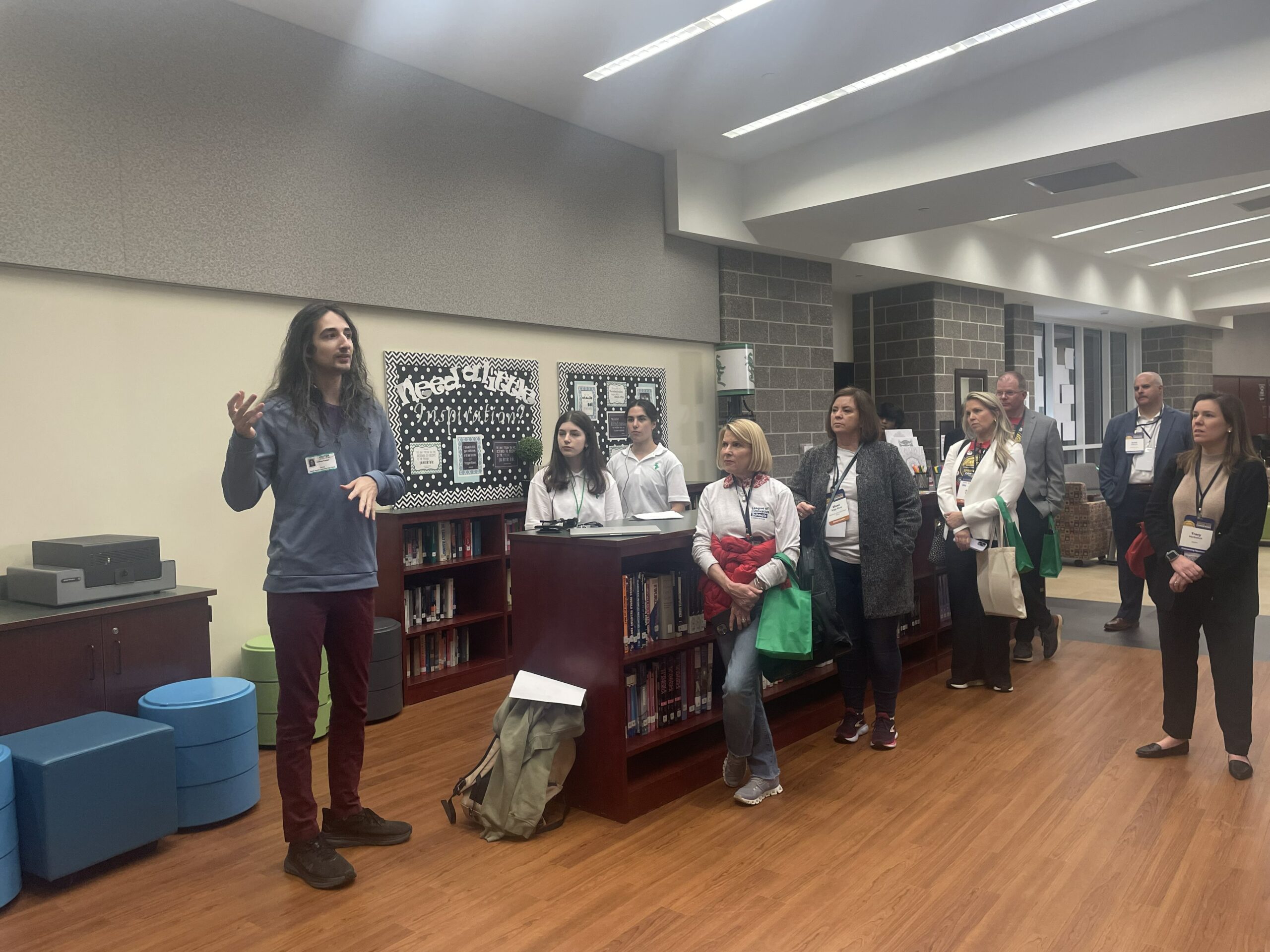It was a hectic week! Starting from the AASA (American Association of School Administrators) showcase at ETC on Monday, Digital Promise on Tuesday, small showcases for guests at the ETC, and preparations for the big Playtesting Day on Saturday, this week was shaped with demoing and playtesting!
Digital Promise
Digital Promise was a rocky day, but we managed to work around all the unexpected problems and tried our best to create still a fruitful experience for all the visitors at South Fayette. We got up early at 6am, in order to get to South Fayette by 7:30 to tech check everything for the conference that would start at 8am. However, an unexpected power outage the night before caused the remote desktop software that connects their computer to their CAVERN computer to break. In addition, some time in the previous week, a fourth monitor was plugged into the CAVERN computer, which broke the warping software’s configuration.
More familiar on the software side of the platform, our team spent a considerable time trying to fix these issues before Steve, the CAVERN builder, was able to run a custom script to fix everything after the conference ended. In the meantime, while Digital Promise was still happening, we adapted our showcase agenda to start from outside of the CAVERN, giving an overview of the platform and talking about our project, and then showcasing our sample scene that was partially warped incorrectly. Fortunately, the detailed oral walkthrough with the aid of Matt, South Fayette’s innovation director, also the person who incorporated CAVERN into the school, as well as the sample scene that despite incorrectly warped, still created an immersive scene that filled audiences’ minds with wonder and inspiration.
In particular, we met many groups of educations that provided us invaluable insights into how the space can be used.
- Multiple K-12 groups mentioned having an Ancient Rome city as part of a History class.
- A person from Julliard was in particularly interested in having CAVERN as a tool to help musicians and performers overcome stage fright.
In sum, although met with challenges, Digital Promise ended with us learning a lot from not only how to fix things on the hardware side, but also future application potential on the software side!
Sample Scene V2

In preparation for the Playtest Day on Saturday, we’ve decided to update our sample scene so that it has serves the following newly identified needs:
- More ranged sceneries to showcase depth, especially as the stereoscopic rendering is a huge feature of CAVERN.
- Vive Tracker interactions that can inspire future creators to build interactive experiences.
- Post processing such as shaders and particle systems to showcase the rendering abilities.
Therefore, we brainstormed a new scene, where the little creatures made earlier in the semester but not present in the first sample scene are now the main characters. In the new sample scene, players will follow the little creature that spawned from a hole in a tree to explore the space. After that, they will in turn guide the little creature to meet with a big creature in the middle of the scene, to trigger a heartwarming hug event!
Finite State Machine
All of us are strong advocates of modular and extensible code (which is why we pitched the project in the first place). Therefore, to support a smooth game development experience, Terri created a custom finite state machine system for Winnie to build the gameplay events, which will also potentially be included in the future releases of the toolkit. Before Playtesting day, the new sample scene with interactions are finally created.
Playtest Plans
After meeting with our advisor Drew, and Consultant Mike, we decided to split our playtesters into two groups: those with Unity experience will be brought to our project room to follow a simple tutorial to play with our toolkit, and see it built on the CAVERN immediately. The other group of people are those who simply want to experience the space, in which we will showcase our sample scene and other demo projects to learn more about the space.
Because each group will only have 20 minutes to playtest, and we also wanted to build up to the CAVERN jam that will happen two weeks later, we created a form to collect contacts of people who are interested in come back and try more features, even potentially creating an experience themselves.

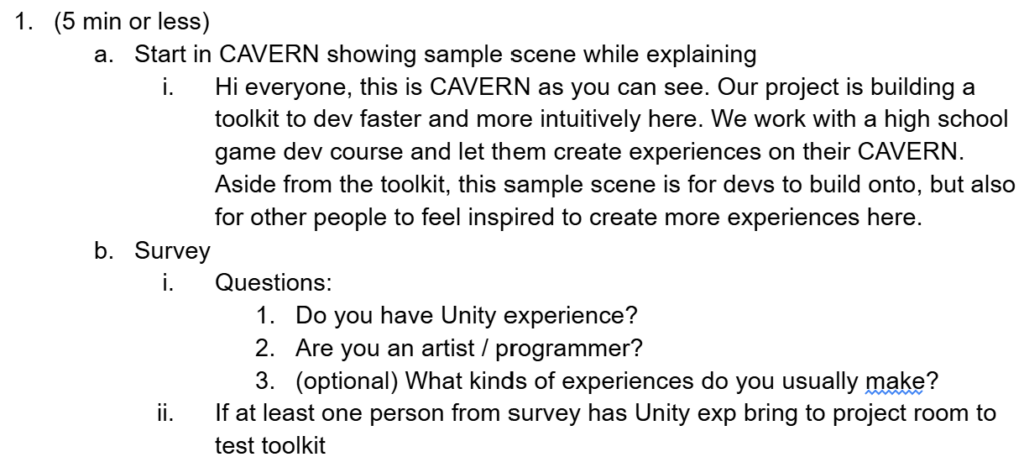
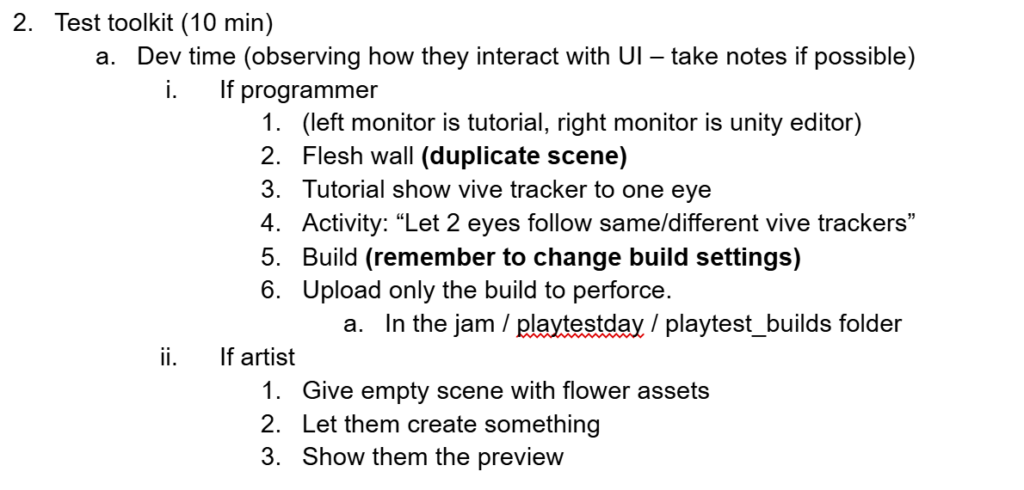
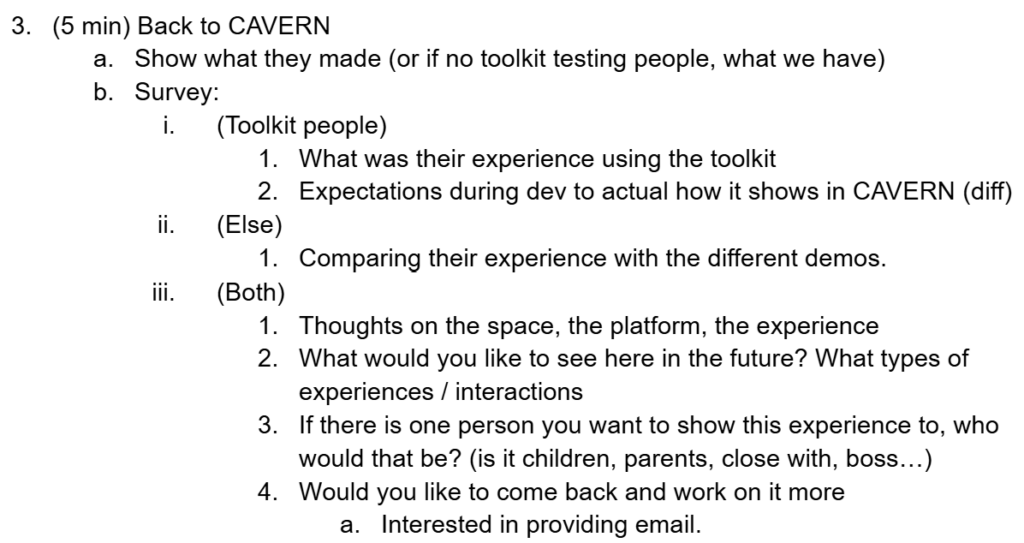
Playtest Day
At the end, out of the 6 groups that came to playtest our project, 3 groups got to test our toolkit, and 3 groups experienced a full range of experiences built on the CAVERN.
20 minutes is not enough!! We learned immensely from every person, and we hoped to talk more. Here is a summarized feedback.
Group 1 Sample Scene Testers (No Unity Experience)
- Found the scene visually calming and immersive, with aesthetic comparisons to indie games and interactive art museums.
- Desired more interactivity, such as drawing, tactile flower interactions, and objects reacting to user proximity.
- Flesh wall was initially creepy but became comforting once the eyes tracked users, making it feel alive and intelligent.
- Noted potential dizziness and suggested limiting time in the experience or designing scenes for therapeutic use.
- Recommended for younger audiences or mindfulness use cases, but not for older individuals like parents.
Group 2 – Sample Scene Testers (Low Unity Experience)
- Felt the space was immersive and fantastical, though movement felt disorienting without proper head tracking.
- Enjoyed the visual environment but found interaction lacking; wanted more reactive elements, characters, and ways to “touch” the experience.
- Compared it favorably to museum-style installations like TeamLab and saw potential for similar public exhibitions.
- Frogs was liked visually but considered too static; they wanted more behavioral realism or playful engagement.
Group 3 – Toolkit Testers (Strong CS Background, Low Unity Experience)
- Quickly understood and enjoyed the toolkit despite minimal Unity experience, helped by clear tutorials and peer observation.
- Successfully completed the Vive tracker activity and showed strong enthusiasm for learning and experimentation.
- Valued immersive audio and visuals, though some visuals (like the eyes) were startling but memorable.
- Interested in returning to build more, and would recommend the platform to friends in both programming and art.
Group 4 – Toolkit Testers (Faculty, Game Dev + Strong Unity Experience)
- Deviated from the standard playtest to explore the toolkit deeply, offering critical technical feedback.
- Emphasized better onboarding through strong naming conventions, scene modularity, and error messages rather than heavy tutorials.
- Suggested improved documentation and alignment with Unity 6.1 tools like the Project Analyser.
- Recommended offering feature-specific starter scenes (e.g., stereoscopic, tracking) for better developer usability.
Group 5A – Toolkit Testers (Students, Game Dev Exp but Not Unity – Programmers)
- Found the development process surprisingly fast and accessible, especially the “flesh wall” creation.
- Requested a broader set of creative assets to build more personalized or complex content.
- Responded positively to technical tools like tracking systems and enjoyed experimenting with interaction design.
Group 5B – Toolkit Testers (Students, Game Dev Exp but Not Unity – Scene Builders)
- Focused on interactive and social potential—suggested mini-games, competitive challenges, and co-op mechanics using tracked real-world movement.
- Pitched ideas like “Overcooked”-style mechanics, and emphasized using the large physical space creatively.
- Interested in peaceful and artistic applications as well, such as cherry blossom-inspired environments.
- Identified varied target audiences: mom (for relaxation), online friends, spouse, and younger sibling (for games).
Group 6 – Sample Scene Testers (University game dev faculty.)
- Impressed by spatial use and visual immersion, particularly when obstructions didn’t interfere with the illusion.
- Loved peaceful experiences but also wanted deeper interactivity—suggested games like basketball, sorting, and time-based challenges using full-body movement.
- Saw potential for both meditative and social or competitive use cases.
- Would share the experience with their mom, spouse, and friends for its mix of therapeutic and playful potential.
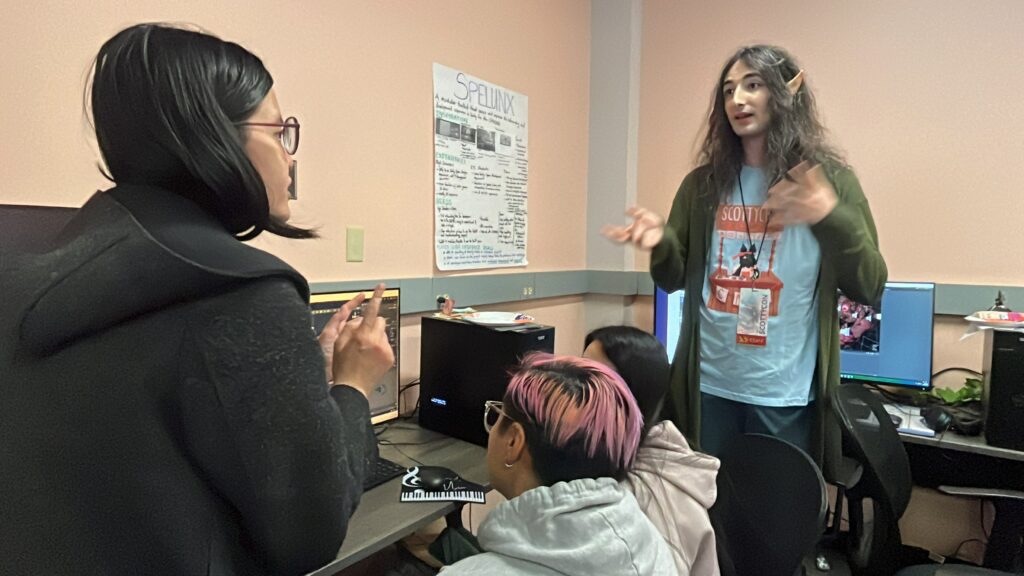
Next Steps
This week started out slightly bumpy due to the unexpected issues at South Fayette. However, we wrapped up a week full of learning from our experiences and also learning from our users with Playtest Day. Now we are excitedly marching towards a new week of refinement to put in our softs presentation, as well as prepare for CAVERN Jam 2.0 on the week after softs.

